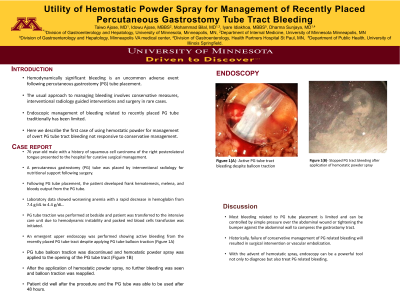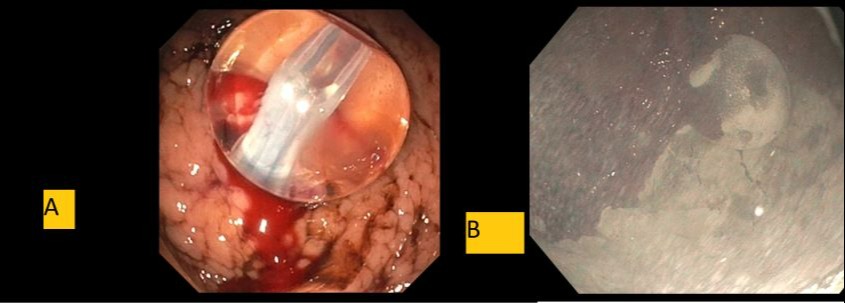Back


Poster Session D - Tuesday Morning
Category: General Endoscopy
D0291 - Utility of Hemostatic Powder Spray for Management of Recently Placed Percutaneous Gastrostomy Tube Tract Bleeding
Tuesday, October 25, 2022
10:00 AM – 12:00 PM ET
Location: Crown Ballroom

Has Audio
- TA
Taiwo Ajose, MD
University of Minnesota Medical School
Minneapolis, MN
Presenting Author(s)
Taiwo Ajose, MD1, Idowu Ajose, MBBS2, Mohammad Bilal, MD3, Iyare Idiakhoa, MBBS4, Dharma Sunjaya, MD3
1University of Minnesota Medical School, Minneapolis, MN; 2University of Minnesota, Minneapolis, MN; 3University of Minnesota, Minneapolis VA Medical Center, Minneapolis, MN; 4Estate Specialist Hospital Warri Nigeria, Atlanta, GA
Introduction: Hemodynamically significant bleeding is an uncommon adverse event following percutaneous gastrostomy (PG) tube placement. The usual approach to managing bleeding involves conservative measures, interventional radiology guided interventions and surgery in rare cases. Endoscopic management of bleeding related to recently placed PG tube traditionally has been limited. Here we describe the use of hemostatic powder for management of overt PG tube tract bleeding not responsive to conservative management.
Case Description/Methods: 76 year-old male with a history of squamous cell carcinoma of the right posterolateral tongue presented to the hospital for curative surgical management. A percutaneous gastrostomy (PG) tube was placed by interventional radiology for nutritional support following surgery. Following PG tube placement, the patient developed frank hematemesis, melena, and bloody output from the PG tube. Laboratory data showed worsening anemia with a rapid decrease in hemoglobin from 7.4 g/dL to 4.4 g/dL.. PG tube traction was performed at bedside and patient was transferred to the intensive care unit due to hemodynamic instability and packed red blood cells transfusion was initiated. An emergent upper endoscopy was performed showing active bleeding from the recently placed PG tube tract despite applying PG tube balloon traction (Figure 1A).
PG tube balloon traction was discontinued and hemostatic powder spray was applied to the opening of PG tube tract (Figure 1B). After application of hemostatic powder spray, no further bleeding was seen, and balloon traction was reapplied. Patient did well after the procedure and the PG tube was able to be used after 48 hours.
Discussion: Most bleeding related to PG tube placement is limited and can be controlled by simple pressure over the abdominal wound or tightening the bumper against the abdominal wall to compress the gastrostomy tract. If these measures fail patient may require interventional radiology guided intervention or surgery, since endoscopic intervention is limited due to our inability to access the bleeding source within the PG tube tract without removing the tube. Hemostatic powder spray allows us to deliver bentonite to the bleeding within the tract itself by absorbing water and creating a barrier that leads to mechanical tamponade and concentration of clotting factors, resulting in enhanced coagulation. In addition, using hemostatic powder spray allows us to salvage the PG tube.

Disclosures:
Taiwo Ajose, MD1, Idowu Ajose, MBBS2, Mohammad Bilal, MD3, Iyare Idiakhoa, MBBS4, Dharma Sunjaya, MD3. D0291 - Utility of Hemostatic Powder Spray for Management of Recently Placed Percutaneous Gastrostomy Tube Tract Bleeding, ACG 2022 Annual Scientific Meeting Abstracts. Charlotte, NC: American College of Gastroenterology.
1University of Minnesota Medical School, Minneapolis, MN; 2University of Minnesota, Minneapolis, MN; 3University of Minnesota, Minneapolis VA Medical Center, Minneapolis, MN; 4Estate Specialist Hospital Warri Nigeria, Atlanta, GA
Introduction: Hemodynamically significant bleeding is an uncommon adverse event following percutaneous gastrostomy (PG) tube placement. The usual approach to managing bleeding involves conservative measures, interventional radiology guided interventions and surgery in rare cases. Endoscopic management of bleeding related to recently placed PG tube traditionally has been limited. Here we describe the use of hemostatic powder for management of overt PG tube tract bleeding not responsive to conservative management.
Case Description/Methods: 76 year-old male with a history of squamous cell carcinoma of the right posterolateral tongue presented to the hospital for curative surgical management. A percutaneous gastrostomy (PG) tube was placed by interventional radiology for nutritional support following surgery. Following PG tube placement, the patient developed frank hematemesis, melena, and bloody output from the PG tube. Laboratory data showed worsening anemia with a rapid decrease in hemoglobin from 7.4 g/dL to 4.4 g/dL.. PG tube traction was performed at bedside and patient was transferred to the intensive care unit due to hemodynamic instability and packed red blood cells transfusion was initiated. An emergent upper endoscopy was performed showing active bleeding from the recently placed PG tube tract despite applying PG tube balloon traction (Figure 1A).
PG tube balloon traction was discontinued and hemostatic powder spray was applied to the opening of PG tube tract (Figure 1B). After application of hemostatic powder spray, no further bleeding was seen, and balloon traction was reapplied. Patient did well after the procedure and the PG tube was able to be used after 48 hours.
Discussion: Most bleeding related to PG tube placement is limited and can be controlled by simple pressure over the abdominal wound or tightening the bumper against the abdominal wall to compress the gastrostomy tract. If these measures fail patient may require interventional radiology guided intervention or surgery, since endoscopic intervention is limited due to our inability to access the bleeding source within the PG tube tract without removing the tube. Hemostatic powder spray allows us to deliver bentonite to the bleeding within the tract itself by absorbing water and creating a barrier that leads to mechanical tamponade and concentration of clotting factors, resulting in enhanced coagulation. In addition, using hemostatic powder spray allows us to salvage the PG tube.

Figure: Figure 1(A)- Active PG tube tract bleeding despite balloon traction
Figure 1(B)- Stopped PG tract bleeding after application of hemostatic powder spray
Figure 1(B)- Stopped PG tract bleeding after application of hemostatic powder spray
Disclosures:
Taiwo Ajose indicated no relevant financial relationships.
Idowu Ajose indicated no relevant financial relationships.
Mohammad Bilal indicated no relevant financial relationships.
Iyare Idiakhoa indicated no relevant financial relationships.
Dharma Sunjaya indicated no relevant financial relationships.
Taiwo Ajose, MD1, Idowu Ajose, MBBS2, Mohammad Bilal, MD3, Iyare Idiakhoa, MBBS4, Dharma Sunjaya, MD3. D0291 - Utility of Hemostatic Powder Spray for Management of Recently Placed Percutaneous Gastrostomy Tube Tract Bleeding, ACG 2022 Annual Scientific Meeting Abstracts. Charlotte, NC: American College of Gastroenterology.
